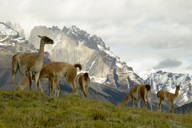

Last month Mary and I guided our first photo tour to Torres
del Paine National Park in Chile. For the record, that trip was
the third in three years to TdP, the first two acting as 'scouting'
trips in preparation for the tour. Next August I'll be leading
our photo tour to Denali National Park in Alaska, a destination
I've photographed in at least 5 times. Both are mountain parks,
so it was natural, then, to consider the similarities and differences
between the two.
Before I pronounce judgment, let me stress that both parks are
great - if one wasn't, I wouldn't bother going! Denali in fall
has its attractions - tundra changing color, caribou shedding
velvet, Denali - the highest mountain in North America - statistically
most likely to be visible.
But Denali is a very difficult park to shoot. Most visitors
are forced to use the public shuttle system which, in my opinion,
is a pathetically inadequate means for photographers to see the
park. Not that anyone listens, but I've often advanced the idea
that a special photography bus should be available - and I'm sure
photographers would pay extra for the chance to get off one bus,
and on to another, without the worry that now exists. Now, when
you get off a bus, there is no guarantee that you will get on
another one for hours if all the seats are filled (no doubt by
people worried about getting off the bus and not being able to
get back on!).
We get around this by using a lodge that has the only permit
to drive a private vehicle into and around the park, so our groups
have far more freedom and access than the usual group, or photographer,
or tourist experiences. However, it is still restricting.
Wildlife regulations are potentially very limiting in Denali,
and I've heard some real horror stories about photographers being
harassed for 'being too close' when a caribou or Dall sheep walked
up to them! Fox dens, wolf dens, bird nests - all are off limits.
Shooting is pretty much a grab-shot basis.
Denali is a spectacular mountain, to be sure, if and when you
see it. But even then, views are pretty much restricted to the
northern side - the mountain is just so big that there's basically
just one broad view. Of course, the north side offers slightly
different views from Eilson Visitor Center, stone mountain, and
wonder lake, but all are from the north.
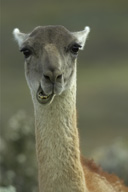 Torres del Paine, in contrast, is a much smaller mountain park,
so it is physically possible to view the mountain massif from
quite different positions. In fact, if you have a few days, you
can walk around the mountain - something that would require weeks,
and considerable effort, in Denali. Denali, at approximately 21,000
feet generates its own weather, and the mountain may be shrouded
in clouds for weeks while the surrounding land is clear. Torres,
in contrast, is a mountain landscape of constant change, and most
days if you wait a few minutes the light, the clouds, the over-all
scene, changes dramatically! OK, 'a few minutes' may be a bit
of an exaggeration, but you get the point.
Torres del Paine, in contrast, is a much smaller mountain park,
so it is physically possible to view the mountain massif from
quite different positions. In fact, if you have a few days, you
can walk around the mountain - something that would require weeks,
and considerable effort, in Denali. Denali, at approximately 21,000
feet generates its own weather, and the mountain may be shrouded
in clouds for weeks while the surrounding land is clear. Torres,
in contrast, is a mountain landscape of constant change, and most
days if you wait a few minutes the light, the clouds, the over-all
scene, changes dramatically! OK, 'a few minutes' may be a bit
of an exaggeration, but you get the point.
Scenically, Torres looks more like the Grand Tetons than Denali,
and like the Tetons, it is more accessible and viewable from several
directions. Like the Tetons, you can get close to the mountain
at Torres - literally at its base from one lookout, so lens choice,
and compositions, are extremely varied.
In many ways Torres is more comparable to the Tetons than Denali,
but because of the remoteness of both destinations - almost at
the ends of their respective continents, I think the Denali comparison
is more apt. Scenically, for all three parks, so much of a photographer's
luck is based upon the light. With Denali - will there be clouds
obscuring the mountain? Will there be alpen glow at sunrise and
sunset? Indeed, will you have a way to get to the mountain to
even shoot alpen glow?
The Tetons are similar, with the landscape best shot at dawn,
hopefully in magical early morning light. The same questions of
weather apply.
Torres del Paine suffers the same questionable woes - will it
be rainy, cloudy, dull in the east or west and muting dawn or
dusk colors? However, there is a huge difference between Torres
and the other parks, for the WIND in Torres is both a curse -
it can be windy! and a blessing. For the wind almost guarantees
that the weather will change, and a rainy dawn doesn't mean that
the day is lost, or that a clear morning insures that the day
will stay clear or windless. In fact, you can almost count on
there being a change.
To me that is a decided advantage, because in the course of a
day one gets a fairly broad spectrum of looks. Even at high light,
if the sun is out but a storm swirls around the mountain peaks,
or drifts through the towers or horns of this mountain massif,
there are wonderful images to be had. On our last trip, while
I scouted an area for puma, I had a magnificent view of the mountains
partially shrouded in clouds, with a knock-out foreground of rounded,
boulder-like cliffs. The scene said it all, and, of course, I
had nothing smaller than a 600mm lens with me!
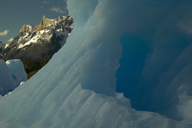 Besides the mountain scenes, both Denali and Torres offer macro
and mini-landscape possibilities. In season, that is, in the fall,
Denali's tundra can glow red as salmon and bear berry undergrowth
change color, and dwarf willows flip from green to bright yellow.
In season - November thru March in Torres, the herbaceous plants
offer their own macro possibilities. In December, when we go to
Torres, the flowering plants are in full bloom and some are wind-resistant
ground huggers and macro shots are possible even in high winds,
assuming you can keep a tripod steady! When it is windless, and
it often is, the possibilities are incredible.
Besides the mountain scenes, both Denali and Torres offer macro
and mini-landscape possibilities. In season, that is, in the fall,
Denali's tundra can glow red as salmon and bear berry undergrowth
change color, and dwarf willows flip from green to bright yellow.
In season - November thru March in Torres, the herbaceous plants
offer their own macro possibilities. In December, when we go to
Torres, the flowering plants are in full bloom and some are wind-resistant
ground huggers and macro shots are possible even in high winds,
assuming you can keep a tripod steady! When it is windless, and
it often is, the possibilities are incredible.
As anyone reading this knows, Mary and I love to shoot wildlife,
and here I think the comparison and striking differences are most
apparent. Here's a list of the wildlife one can expect to see
in Denali, with a * indicating those where there's an excellent
chance of getting a reasonable photo - ie almost a certainty,
and a # for a fair chance. No mark indicates little chance of
getting a shot, based upon a typical one-week trip.
Much of Denali's wildlife viewing and photography is done from,
or quite close to, the buses. This is limiting, and although we've
done OK or fairly well with many species over time photographers
must realize that there is 'a chance' of photographing a lot of
animals, but little likelihood of doing so very well. For example,
I've photographed wolf once, and red fox twice in several visits.
| Caribou | # | * |
| Moose | # | |
| Dall sheep | ||
| Gray wolf | ||
| Red fox | # | |
| Hoary Marmot | # | |
| Pika | # | |
| Beaver | # | |
| Arctic ground squirrel | * | |
| Grizzly bear | # | |
| Red squirrel | * | |
| Willow Ptarmigan | * | # |
| Eagles,loons,chicadees | # |
Caribou can usually be shot from the bus, but good shooting requires being on foot, hence the dual listing. On our tours we've done fairly well with caribou by hiking across the tundra to them, and have had about 50% luck with moose --- sometimes getting them, sometimes not. Dall can be found and shot, but from the bus it is a joke and Dall sheep can be a # if one has the time, and the energy to hike to the ridges where they may be found, but it is a brutal walk without certainty. Hoary marmots and pikas are a sure thing, but to get to them you must make a good uphill climb. Some groups have no inclination to do so, or lack the time, so I've not given the sheep a rating and a modest one for the others since there is often no opportunity toget them. Willow ptarmigan can be great if you find them on foot, but they're rather mediocre from the bus. The last birds are occasionally shot -- the best chances are generally with loons.
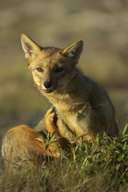 In
contrast, Torres del Paine has fewer mammals but a much larger
variety of birds. With the exception of the flightless rhea, all
the birds and mammals are most effectively photographed on foot!
Rheas are often skittish and most good shots are done from a window
- an impractical means of shooting with a group.
In
contrast, Torres del Paine has fewer mammals but a much larger
variety of birds. With the exception of the flightless rhea, all
the birds and mammals are most effectively photographed on foot!
Rheas are often skittish and most good shots are done from a window
- an impractical means of shooting with a group.
Here's the subjects one can expect to see in Torres, and I've
assigned the numbers 3, 2, and 1, for the number of times I've
photographed these subjects well. A 3 indicates I've shot them
well on all 3 trips, a 1 that I've succeeded one time out of 3.
A * indicates that there is a good chance of getting photos even
if I haven't, simply because I didn't take the time to do so,
and a # a fair chance.
| Guanaco | 3 | * |
| Patagonian Gray Fox | 3 | * |
| Andean Red Fox | 2 | * |
| Puma | 1 | # |
| Huemule Deer | 1 | # |
| Black-necked Swan | 2 | * |
| Coscoroba Swan | 1 | # |
| Chilean Flamingo | 1 | # |
| Andean Condor | 2 | # |
| Magellanic Woodpecker | 1 | * |
| Rhea | 1 | # |
| Austral Parakeet | 2 | * |
| Upland Goose | 3 | * |
| Brown-hooded Gull | 3 | # |
| Buff-necked Ibis | 1 | # |
| Austral Thrush | 2 | * |
| Rufous Collared Sparrow | 3 | * |
| European Hare | 1 | # |
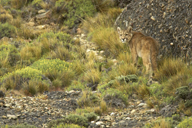 The puma-1# requires work, as days must be devoted to looking
for them in the predawn hours, but they're almost a sure thing
if one is located. The foxes are easy -- they're generally denning
during our tours. The Magellanic woodpecker-1* is easy if a nest
is located! Just birding, one can expect to see at least 30 species
(I've seen as many as 70), and depending upon the effort put forth
one could photograph several songbirds quite well if one applied
oneself.
The puma-1# requires work, as days must be devoted to looking
for them in the predawn hours, but they're almost a sure thing
if one is located. The foxes are easy -- they're generally denning
during our tours. The Magellanic woodpecker-1* is easy if a nest
is located! Just birding, one can expect to see at least 30 species
(I've seen as many as 70), and depending upon the effort put forth
one could photograph several songbirds quite well if one applied
oneself.
As you can see from the list although there are not as many mammals,
you have a much better chance of photographing these mammals than
you do with Denali's mammals. The bird opportunities are far better
in Torres as well.
Where am I leading with this? Well, I love Torres del Paine.
Although it reminds me so much of Denali with the mountain and
road system (which is far more extensive in Torres by the way),
the shooting opportunities are far superior. We can use a private
vehicle in Torres, stopping wherever we wish, and we can get out
and walk and shoot virtually anywhere. Not that this is always
easy - our group had to hike uphill (imagine that!) to have frame-filling
Andean condors soaring by, and uphill hikes might be required
to get guanacos lined up against the mountains. Mary and I put
in 1 ½ days before I found our puma, and on our first day
of searching I didn't take a single picture! However, for those
who are willing to put in some effort, who are willing to hike
or to wait for the light, the scenics and wildlife of Torres del
Paine are simply incredible. East Africa offers more bird and
wildlife shooting, of course, but mostly from a vehicle. On foot,
in the foothills of the Andies, it's a whole different shooting
experience, and a most wonderful one.
|
|
|
|
Flash-Remotes |
|
NANPA |